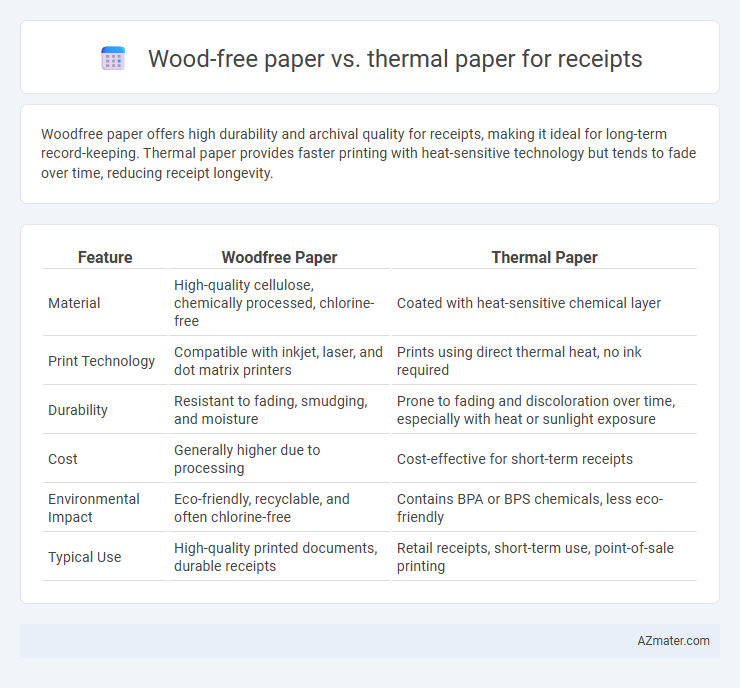Woodfree paper offers high durability and archival quality for receipts, making it ideal for long-term record-keeping. Thermal paper provides faster printing with heat-sensitive technology but tends to fade over time, reducing receipt longevity.
Table of Comparison
| Feature | Woodfree Paper | Thermal Paper |
|---|---|---|
| Material | High-quality cellulose, chemically processed, chlorine-free | Coated with heat-sensitive chemical layer |
| Print Technology | Compatible with inkjet, laser, and dot matrix printers | Prints using direct thermal heat, no ink required |
| Durability | Resistant to fading, smudging, and moisture | Prone to fading and discoloration over time, especially with heat or sunlight exposure |
| Cost | Generally higher due to processing | Cost-effective for short-term receipts |
| Environmental Impact | Eco-friendly, recyclable, and often chlorine-free | Contains BPA or BPS chemicals, less eco-friendly |
| Typical Use | High-quality printed documents, durable receipts | Retail receipts, short-term use, point-of-sale printing |
Introduction to Receipt Paper Types
Woodfree paper, predominantly made from chemically processed pulp without lignin, offers a smooth, high-quality surface ideal for printing detailed receipts with sharp text and images. Thermal paper, coated with heat-sensitive chemicals, provides fast and quiet printing without ink, making it highly efficient for point-of-sale systems and durable for short-term use. Receipt paper selection depends on factors like print quality, durability, and cost-efficiency, with woodfree paper preferred for archival quality and thermal paper favored for rapid, low-maintenance printing.
What is Woodfree Paper?
Woodfree paper is a high-quality, cellulose-based paper made from chemical pulp with most lignin removed, resulting in a smooth, durable surface ideal for printing detailed receipts. Unlike thermal paper, which relies on heat-sensitive coatings to produce images, woodfree paper offers superior archival properties and resistance to fading over time. This makes woodfree paper preferred for receipts requiring longevity and enhanced print clarity.
What is Thermal Paper?
Thermal paper is a specially coated paper that changes color when exposed to heat, making it ideal for receipt printing without the need for ink or toner. Unlike woodfree paper, which is chemically processed to remove lignin for a smoother writing surface, thermal paper contains heat-sensitive layers that enable fast, high-quality prints with crisp text and images. This technology is widely used in point-of-sale systems due to its efficiency, cost-effectiveness, and reliable print durability under normal handling conditions.
Print Quality Comparison
Woodfree paper offers superior print quality for receipts due to its smooth, uncoated surface that allows for sharp text and clear graphics with traditional ink-based printers. Thermal paper produces receipts through heat-sensitive coatings that yield fast, consistent prints ideal for high-speed transactions, but can fade over time and may show less detail in fine print or images. When evaluating print sharpness and durability, woodfree paper excels in longevity and visual clarity, while thermal paper prioritizes speed and cost-efficiency.
Durability and Longevity
Woodfree paper offers superior durability and longevity for receipts due to its higher resistance to fading, tearing, and environmental factors like moisture and UV exposure. Thermal paper, while cost-effective and convenient for quick printouts, tends to degrade faster, with images susceptible to fading over time when exposed to heat or light. Choosing woodfree paper ensures receipts maintain legibility and physical integrity for extended periods, essential for record-keeping and archival purposes.
Environmental Impact
Woodfree paper, made from chemically treated pulp, offers higher print quality but involves intensive chemical processing that can contribute to water pollution and increased energy consumption. Thermal paper, commonly coated with BPA or BPS, raises significant environmental concerns due to chemical leaching and challenges in recycling, leading to greater landfill waste and potential ecological toxicity. Choosing recycled or BPA-free thermal paper and proper disposal methods mitigates environmental impact compared to conventional woodfree or coated thermal receipt papers.
Cost Differences
Woodfree paper receipts typically have a lower initial cost than thermal paper, making them budget-friendly for high-volume printing needs. Thermal paper, though generally more expensive upfront, reduces expenses over time due to its printer's lower maintenance and faster printing speed. Businesses must weigh the upfront cost savings of woodfree paper against the long-term operational savings offered by thermal paper.
Suitability for Different Businesses
Woodfree paper offers high-quality print clarity and is ideal for businesses requiring durable, smudge-resistant receipts such as retail stores and restaurants. Thermal paper excels in cost-effectiveness and fast printing speeds, making it suitable for environments like supermarkets and ticketing where quick, frequent printing is essential. Choosing between woodfree and thermal paper depends on factors like print longevity, environmental conditions, and transactional volume specific to the business type.
Health and Safety Considerations
Woodfree paper for receipts generally contains fewer chemical additives compared to thermal paper, reducing potential skin irritation and allergenic reactions. Thermal paper often uses BPA or BPS chemicals as heat-sensitive agents, which have raised health concerns due to their endocrine-disrupting properties. Choosing woodfree paper can minimize exposure to harmful substances, promoting safer handling for both consumers and employees.
Choosing the Right Paper for Receipts
Woodfree paper offers excellent print quality and durability, making it ideal for receipts that need to last longer and withstand handling. Thermal paper provides fast, cost-effective printing by using heat-sensitive coating, suitable for high-volume, short-term receipts in retail or hospitality sectors. Selecting the right paper depends on factors like print durability, cost efficiency, and the type of printer used in your business environment.

Infographic: Woodfree paper vs Thermal paper for Receipt
 azmater.com
azmater.com